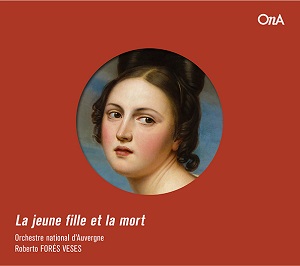Schuberts d-Moll-Quartett (Der Tod und das Mädchen) wurde im Jahr 1894 von Gustav Mahler für Streichorchester gesetzt. Sein Unterfangen blieb in der Folge umstritten, obschon er in diesem Werk keine instrumentatorischen Eingriffe vorgenommen hat (wie im Fall der Beethoven- und Schumann-Symphonien etwa), sondern nur eine Erweiterung und Differenzierung der Streicherstimmen mit hinzugefügter Kontrabassstimme.
Und weil Schubert sich mit seinen letzten Quartetten nach eigener Angabe den « Weg zur großen Symphonie bahnen » wollte, kann man eine solche Bearbeitung, wie sie das Streichorchester des Orchestre National d’Auvergne spielt, gutheißen.
Die Auvergnats spielen das Schubert-Quartett in den Ecksätzen und im Scherzo recht dramatisch, mit viel Impetus und federndem Schwung und bringen so tatsächlich ein Plus an Sound und an Wirkung. Im Gegensatz zu meinem Eindruck in der Aufnahme der Sinfonietta Amsterdam (BIS, 1994) vermisse ich im Andante die Intimität des Quartetts nicht. Roberto Fores-Veses gelingt es, seine Musiker zum Wesen dieser Musik hinzuführen. Im letzten Satz braucht er wohl nur knappe acht Minuten, aber weil der Satz im Tempo doch stark differenziert wird, kommen Schuberts Getriebensein und Verzweiflung gut zum Ausdruck.
Es folgt eine beachtliche, eindringlich gespielte, sehr expressive Interpretation des bekannten Quartettsatzes D. 703. Die Streichergruppe des Orchestre National d’Auvergne wird dabei bestens von der Aufnahmetechnik eingefangen.
Schubert’s D minor quartet (Death and the Maiden) was set for string orchestra by Gustav Mahler in 1894. His undertaking subsequently remained controversial, although he did not make any instrumental interventions in this work (as in the case of the Beethoven and Schumann symphonies, for example), but only an expansion and differentiation of the string parts with the addition of a double bass part.
And since Schubert, by his own admission, wanted to « pave the way to the great symphony » with his last quartets, one can approve of such an arrangement as played by the string orchestra of the Orchestre National d’Auvergne.
The Auvergnats play the Schubert Quartet quite dramatically in the outer movements and in the Scherzo, with plenty of impetus and supple momentum, and thus actually add to the music’s sound and impact. Unlike my impression in the Sinfonietta Amsterdam recording (BIS, 1994), I don’t miss the intimacy of the quartet in the Andante. Roberto Fores-Veses succeeds in leading his musicians to the essence of this music. In the last movement, he probably only needs a scant eight minutes, but because the movement is nevertheless strongly differentiated in tempo, Schubert’s driven nature and despair are well expressed.
This is followed by a remarkable, forcefully played, very expressive interpretation of the well-known Quartet Movement D. 703, with the string section of the Orchestre National d’Auvergne well captured by the recording technique.





















